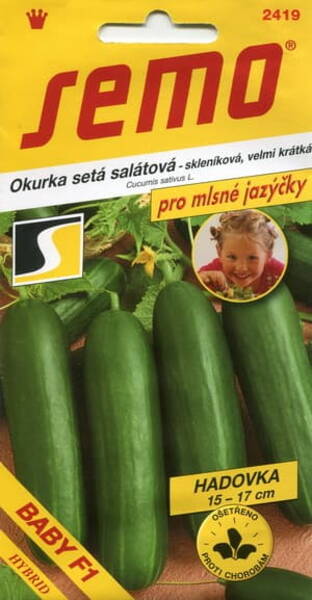A very early, high yielding, "mini salad" type self-pollinating hybrid. Semi-long.
Grown in pots - open balconies, PE greenhouses. Fruits are green, smooth, 15-17 cm long, weight 290-320 grams, not bitter, very tasty, good consistency. Fruits can be picked when they are 15 cm long. The hybrid is resistant to virus and fungal disease - cucumber mosaic virus (CMV), downy mildew, scab (Ccu) - the resistance will help you to grow high-quality harvest without using chemicals, in accordance with agro-technical requirements. Optimum seed germination temperature +27+28°C.
1-2 seeds are sown to the pots; the hardiest plant is then replanted to the permanent place. Cucumber seedlings grow within 25-30 days. Seedlings grown in February require additional light. 1 m² can accommodate 1-2 plants. 10 seeds will cover the area of 5-8 m2 - the forecasted harvest under favourable growing conditions is 45-60 kg.
* Not every gardener knows that some methods of preparation can not only improve the quality of future seedlings, but also bring old seeds with an expired shelf life back to life. At the same time, many people have packets of seeds during a pre-sowing inspection that are at least 2-3 years old, and sometimes even 5-10 years old. For some reason, they were forgotten "in the backyard" and not given a chance immediately after purchase. What to do with such seeds - sow or throw away?
There is a clear answer to this question: never throw away the seeds, even if you found them in your grandmother's chest, which is several decades old! Many expired and partially lost germination seeds can be revived. In the case of flowers, this may be more difficult than with vegetable crops, but it is still worth a try.
Methods for restoring the vitality of seeds:
* Soaking seeds in aloe juice.
Aloe juice is a truly miraculous remedy, practically "living water" for any organism, including expired seeds. Aloe has been used to improve the germination of seed material for a long time, when there was not such a variety of growth stimulants in garden stores.
To treat old seeds, you can use aloe juice in ampoules from the pharmacy or fresh juice from the leaves of a bush growing in your home.
To collect aloe juice, you need to cut off the lower branches of an adult (over 3 years old) aloe bush, which has previously been left without watering for about two weeks. The cut leaves are wrapped in thick cloth or paper and put in the refrigerator for a week or two. After this time, they are cut and the pulp is taken out or the juice is squeezed out.
You can soak the seeds either in pure juice or in juice diluted with water in equal proportions. Some gardeners place the seeds directly into the pulp of the plant - this is also a working option.
Keep the seeds in a natural stimulant for at least 6 hours, then dry them slightly and sow them in the soil. There is no need to wash the substance off them.
* Soaking seeds in a growth stimulant.
If you have expired vegetable and flower seeds, but no aloe juice - no problem! The task of reviving them can be perfectly solved by one of the industrial growth stimulants: Epin, Kornevin.
These preparations are designed to help plants cope with the stress of transplantation, unfavorable conditions or improper care. The active substances of these products activate all biological processes, including seed germination.
To prepare a solution for reviving seeds, you need to dilute the preparation in accordance with the instructions (as a rule, it is recommended to use 1-2 g of the substance per 1 liter of water). Do not forget to use gloves during work.
Soak the seeds in an immunostimulant solution for 2-3 hours, then dry and sow in seedling containers or directly into open ground.
* Soaking in hydrogen peroxide.
A very simple and at the same time effective way to increase germination and speed up the germination of old seeds is to keep them in a weak solution of hydrogen peroxide. To obtain the desired concentration, 3% hydrogen peroxide is mixed with ordinary water in a ratio of 1:9. The seeds are poured with the solution and left for a period of two hours to a day - the soaking time depends on the age of the seeds (the older, the longer), their size and the characteristics of the plant.
An additional oxygen atom in the peroxide allows you to open a "second wind" for expired seeds, which has a beneficial effect on the germination of even very expired seed material.
* The "temperature shock" method.
The essence of the method is to create a temperature shock in the seeds - this technique is successfully used to revive even 10-year-old seed material.
1. Take two containers and fill them with water with a large temperature difference: hot water (about +60°C) is poured into one, and cold water into the other.
2. Place the seeds in a small linen bag or tie them in a piece of linen or cotton fabric.
3. Alternately lower the seeds into containers of water, starting with hot water, and hold them there for no longer than 4-5 seconds. A total of 5-6 immersions are required.
4. Then lay the seeds on paper or fabric to dry, and then sow them in the soil in the usual way.
In this way, you can "revive" almost any seeds, except for particularly demanding crops. However, the "contrast method" is not suitable for seeds that have been stored incorrectly - for example, in high humidity or with sudden temperature changes.
Whichever method of soaking seeds you choose, remember one important rule: before dipping the seeds into the stimulant solution, hold them for an hour or two in ordinary water at room temperature. It is advisable to use soft, settled or melted water for this. Only after the seeds are saturated with clean water and slightly swell - they can be soaked in the working solution. Without such a preliminary procedure, the seeds can absorb too much of the stimulating solution and simply "burn".
Ripened flower seeds, under the right storage conditions, retain their germination capacity for an average of 5-8 years. At the same time, the viability periods of different crops may vary: marigolds can sprout only within 1-2 years after collection, and the seeds of fragrant tobacco will germinate after 8 years. Germination is related to the amount of nutrients in the seed, but does not depend on its size.
The conditions in which the packets were stored are of great importance for the successful resuscitation of expired seeds. If you "temporarily" placed them in a kitchen cabinet above the stove or sink, where they experienced all the delights of changing temperature and humidity, the chances of reviving such seeds will be small.
If the precious material was stored as it should be - in a cool, dark place - then why not give such seeds a second chance? Perhaps you will get luxurious plants from them, blooming "like the last time"!
When deciding the fate of packets of expired seeds found in stock, remember that the expiration date, allowing the sale of seed material, is not equal to, and in most cases is significantly less than, the shelf life of the seeds.
* A small crop is due to a lack of water or fertilizer. Maintain constant soil moisture and feed the plants about once every three weeks. Fruit collection must be carried out regularly so that the plant can continue to bear fruit. If mature fruits outgrow, the plant will no longer form new ovaries.












